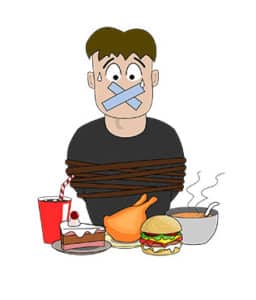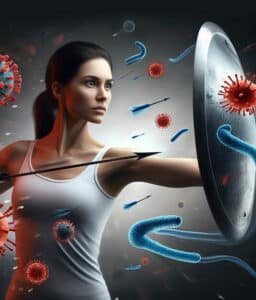What is metabolism and how does it work?
We often hear people say 'I have a slow/fast/broken metabolism' and we nod in agreement. But do we understand what it means?
A "slow" metabolism is also often cited as a cause of weight gain and many other health problems as well. Is it really so? And if it really is, is it possible to speed up the metabolism to burn more calories?
To better understand what metabolism really is and how it works - let's start with physics.
Energy balance
As complicated as biology may seem to us, ultimately we all exist in a physical world where our bodies are subject to the laws of physics.
Energy balance is a concept that helps us understand how people gain, lose, and maintain weight. It is based on one of the basic concepts of physics, specifically, on the law of conservation of energy - "Energy cannot be created or destroyed in an isolated system".
That is, energy cannot disappear anywhere or arise by itself. Our body can only receive it from the outside with food and use it for life support, tissue synthesis and body movement. We cannot use more energy than we have taken in, and if we do not use it, it does not disappear anywhere, but is stored for future use.
The math is very simple:
- If the energy that enters the body is greater than the energy that is used - the body has a surplus of energy (which is converted and stored in fat);
- If the energy that enters the body is less than the energy that is used - the body has an energy deficit (which is compensated by using the accumulated "reserves");
- If the energy entering the body is equal to the amount of energy used, the body has energy balance.
Energy sources
Energy enters our body through food, which consists of carbohydrates, fats and proteins. These nutrients are broken down in the digestive tract into their simplest forms – glucose, fatty acids and amino acids and are transported throughout the body by blood.
However, we cannot use energy directly from glucose, fatty acids and amino acids - they must first be converted to adenosine triphosphate (ATP) – an energy source that our body uses to obtain and store energy at the cellular level.
The body stores a minimal amount of ATP in the muscles, but these stores are used literally in a few seconds - therefore, ATP stores must be constantly replenished (new ATP molecules must be continuously synthesized).
This synthesis is carried out by 3 systems/processes in our body:
- Phosphagen system (also called ATP-PC). It is used during short, intense activities when the muscles need a large amount of energy. In about 2 to 3 seconds, all the ATP stored in the muscles is used. After that, for another 6 to 8 seconds, ATP is synthesized from creatine phosphate - until its stores also run out. If the need for energy remains, the body will continue to synthesize ATP by switching to aerobic or anaerobic metabolism (glycolysis).
- Glycolytic system / Anaerobic metabolism (oxygen is not used in the metabolic process). Glycolysis is the dominant energy system and is the second fastest form of ATP synthesis. ATP is synthesized from glucose in the blood and glycogen stored in muscles and liver. Glycolysis, during high physical exertion, provides the body with energy for about 2 to 3 minutes until glucose and glycogen stores are depleted. Glucose and glycogen stores are replenished in a ratio of 1:2 - if the duration of activity is 2 minutes, the stores are replenished in about 4 minutes at rest (as long as there are nutrients in the digestive tract).
- Oxidative system / Aerobic metabolism (the metabolic process requires oxygen). ATP is synthesized from carbohydrates and fats, which cannot be "burned" without oxygen. The oxidative system provides the body with energy during prolonged, low-intensity loads. This energy system primarily “burns” fat. The percentage use of fats and carbohydrates depends on the intensity and duration of physical exercise - during shorter and more intense activities, carbohydrates are used more, because energy can be obtained from them faster, while fats are used more during longer, less intense activities.
During physical activities, all three energy systems work - only with a different level of involvement, which depends on the duration and intensity of the activity.
Comparison of the rate and extent of ATP synthesis of the body's energy systems:
| The rate of ATP synthesis | The amount of ATP synthesis | Used for ATP synthesis |
Phosphagen system | Very high | Very low | Creatine phosphate |
Glycolytic system / Anaerobic metabolism | High | High | Blood glucose. Glycogen stored in muscles and liver. |
Oxidative system / Aerobic metabolism | Low levels of | Very high | Blood glucose. Glycogen stored in muscles and liver. Fat. |
The level of energy (ATP synthesis) of the body's energy systems during exercise:
Energy consumption
Our bodies need energy even when we are at rest or sleeping because processes such as maintaining body temperature, breathing, blood circulation, regulating hormone levels, and cell growth and repair are not interrupted for a moment.
The amount of energy/calories our body uses to perform these basic functions is called basal metabolism (BMR) and make up about 60 to 70 percent of the total amount of energy we use in one day.
Basal metabolism is different for each person. This is determined by several factors, including:
- Body size and The composition. People who are bigger or have more muscles require more energy/calories to maintain life processes even at rest;
- Men generally have less body fat and more muscle than women (of the same age and weight), so men need more energy (muscle 'uses' more energy than fat).
- As we age, muscle mass tends to decrease and fat mass increases. As a result, the body also needs less energy.
In addition to basic metabolism, energy is also needed for:
- For food processing (TEF). Digestion, absorption, transport and storage of ingested food require energy. About 10 percent of the total daily energy consumption is used for this purpose;
- For physical activities. Any movement of the body requires energy and for this purpose about 20 to 30 percent of the energy consumed during the day is used. Daily physical activity is usually divided into 2 parts:
- In the thermogenesis of non-exercise activities (NOT) – all daily activities except deliberate exercise. About 100 to 800 Kcal are consumed every day just for walking, cleaning the apartment, etc.;
- In exercise activity thermogenesis (EAT). Calorie consumption depends only on ourselves. For example, I spent 200 to 300 Kcal during an hour long workout, but for less trained people it could be 300 to 600 Kcal.
Metabolism and weight
It can be tempting to blame your metabolism for weight gain.
But as you can see, everything is much simpler.
One of the most common causes of weight gain is unconscious energy/calorie intake, from a few candies or cookies to sweetened drinks and packaged juices. Plus water retention if you often eat ultra-processed food and take in too much salt with it.
Candy, chocolate and cookies are not bad in themselves. I like them too and I eat them too.
But it must be remembered that if we take in more energy than we expend, there is an excess of energy, which our body stores in the form of fat. Respectively, if you like to eat, you must also increase your energy consumption 😊.
Excessive weight gain is only rarely caused by medical problems such as Cushing's syndrome or hypothyroidism – usually we create it ourselves with our dietary habits and lifestyle (combination of sleep, physical activity and stress).
All these factors disturb the body's energy balance and - You gain weight because you eat more calories than you burn, or - you burn less calories than you eat.
Metabolism, nutrition and physical activity
We cannot control our basal metabolic rate*, but we can:
- Control the amount of energy (calories) taken in;
- By changing your eating habits, increase the amount of energy needed for food processing. The body consumes 20-30% of the energy contained in proteins for digestion, 5-10% for processing carbohydrates, and only 0-3% for fat. Thus, when eating protein-rich products, our body actually receives only 70 to 80 percent of the energy contained in them, besides, 1 g of fat contains 9 calories, and 1 g of protein - only 4.
- Use more energy by increasing your physical activity.
Aerobic exercises (walking, cycling, swimming, etc.) are the most effective way of "burning" calories.
Experts also recommend strength training at least twice a week, as it helps build muscle. Muscle tissue consumes more energy (burns more calories) than fat tissue, so the greater the muscle mass, the more energy is needed to maintain it.
* The only way we can increase the amount of energy required for basic metabolism is body recomposition, but since the muscles grow slowly, the result will not be noticeable quickly.
Key takeaways
The exchange of substances and energy between the organism and the external environment is a fundamental property of living matter. The food we eat serves as a source of energy. As it breaks down in our digestive tract, the chemical energy is converted into other forms of energy. Most of the chemical energy is immediately converted into heat energy, and the rest into mechanical and electrical energy, which is used in tissue and system functions. These types of energy also eventually turn into heat energy - warms and maintains a constant body temperature.
It is true that metabolism (the total amount of energy used by the body) is related to weight, as it takes more energy to maintain a larger body. However, contrary to popular belief, a slow metabolism (lower total energy consumption by the body) rarely causes excess weight gain.
There are no miracles, supers, etc., diets, pills, teas, etc., that help to reduce weight, because it is possible to speed up the metabolism (the total amount of energy consumed by the body) only by increasing the muscle mass and/or the level of physical activity.
All slimming miracle drugs reduce the amount of energy intake. But because "money doesn't stink" and the manufacturers/distributors of these miracle cures don't have to prove that their products are safe or effective, they can cause unwanted or even dangerous side effects.
If you want to lose weight in a healthy way (up to 0.7 kg per week), simply reduce your energy intake (calories) by 500 to 700 calories per day. If you want to lose weight faster, try to move more.
Or – sign up for my slimming challenges, during which I try to give the participants an idea of how to lose weight in a healthy way, without fasting and the discomfort associated with it.

Help to maintain this site, create interesting articles and delicious low-calorie recipes!
Share this article
Follow me on Facebook
I recommend reading these articles as well

What is a healthy lifestyle
It is clear to everyone that a healthy lifestyle is better than an unhealthy one, but what exactly is a healthy lifestyle?

About "fast weight loss"
Well, what's hot and many are in a hurry to fix what can still be fixed - during the winter and Covid's "work"…. Clubs are closed, but places and opportunities for sports can always be found. And that is what we are doing and will be doing hard now. Is not it so?


Why can't I lose weight?
How to lose weight and the top 12 reasons you lose less weight than expected.


